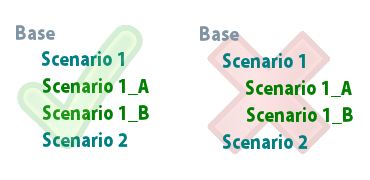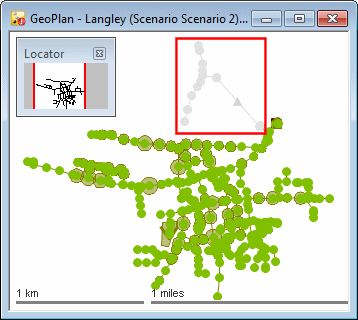About scenarios
Scenarios can be used to model variations of a network simultaneously without the need to create separate branched networks.
For example, scenarios can be a very useful tool if used to investigate the impact of different parameters (pipe size, pipe material, for example) on simulations.
As scenarios are derived from a base network, they do not appear in the Model Group window as separate entities but are saved within the base network and are viewed by opening the base network and selecting the scenario to be viewed from the Scenarios toolbar.
Any changes made to the base network are copied to scenarios.
Notes:
- If changes are made to a field of a network object in a scenario so that the value of the field in the scenario differs from the value of the field in the base, subsequent changes in the base network to the same field will NOT be carried over to that scenario.
- If changes are subsequently made to the same field in the scenario so that the value of the field in the scenario is set to the same as the base, the link between the objects in the base and scenario is re-established and changes made in the base will be visible in the scenario again.
Network objects present in the base network but not in the current scenario are displayed as a faded grey colour in the scenario GeoPlan window. Display of these 'object ghosts' can be turned on/off from the Visual Page of the GeoPlan Properties dialog.
The InfoWorks WS Pro Scenarios toolbar contains functionality allowing users to:
- view excluded objects in a grid
- restore excluded objects to a scenario
Important note about the structure of scenarios
Scenarios are not structured in the same way as most InfoWorks WS Pro objects, therefore it is important to highlight the following points:
- Scenarios can be created from a base network. Any subsequent change to the base will cascade down to the scenarios.
- It is also possible to create copies of scenarios. This is equivalent to the Copy/ Paste operation that computer users are accustomed to using, that is:
- Copied scenarios are duplicates or direct copies of the scenario they originate from.
- Copied scenarios are independent from the original scenario.
- Scenarios that are copies of the same scenario are not linked in any way.
- Changes made to the original scenario do not cascade down to the scenario copies.
If we take the example below, where two scenarios, Scenario 1 and Scenario 2 have been generated from the base. Scenario 1 and Scenario 2 are independent from each other. However, changes made to the base will be cascaded down to both scenarios.

Scenario structure
Scenario 1_A and Scenario 1_B are duplicates of Scenario 1, and were obtained by copying Scenario 1. Scenario 1_A and Scenario 1_B are independent from each other. Making changes to Scenario 1_A will have no impact on Scenario 1_B and vice-versa. Similarly, editing or even deleting Scenario 1 will have no influence whatsoever on Scenario 1_A and Scenario 1_B. This is why the structure of scenarios can be represented by the image on the left (green tick) rather by than the one on the right (red cross).

